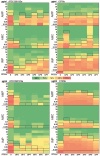The Combination of Phage Therapy and β-Lactam Antibiotics for the Effective Treatment of Enterococcus faecalis Infections
- PMID: 39795870
- PMCID: PMC11719584
- DOI: 10.3390/ijms26010011
The Combination of Phage Therapy and β-Lactam Antibiotics for the Effective Treatment of Enterococcus faecalis Infections
Abstract
A phage-antibiotic synergy could be an alternative in urinary tract infection (UTI) therapy, as it leads to the elimination of bacteria and to the reduction in variants resistant to phages and antibiotics. The aims of the in vitro study were to determine whether phages vB_Efa29212_2e and vB_Efa29212_3e interact synergistically with selected antibiotics in the treatment of E. faecalis infections, to optimize antibiotic concentrations and phage titers for the most effective combinations, and to assess their impact on the number of spontaneous resistant variants and on the phages' reproductive cycles. The modified double-layer disc diffusion method, checkboard, time-kill assays, one-step growth method and the double agar overlay plaque assay were implemented. Synergistic interactions were most often observed after the combined action of phages 2e or 3e and β-lactam antibiotics on E. faecalis strains. The beneficial effects depended on the bacterial strain, phage and antibiotic used. The lowest minimum inhibitory concentration (MIC50) values of the antibiotics were recorded, after the application of low titers of phage 2e, and high titers of phage 3e. The combined use of the tested agents resulted in a significant reduction in the number of resistant variants and had an impact on the reproductive cycle of the tested phages, e.g., a 50% increase in burst size, and a 5 min reduction in the latency period of 2e were observed. The study confirmed beneficial interactions between phages and β-lactam antibiotics against E. faecalis growth.
Keywords: Enterococcus faecalis; phage–antibiotic synergy; urinary tract infections; β-lactam antibiotics.
Conflict of interest statement
The authors declare no conflicts of interest.
Figures





References
-
- Álvarez-Artero E., Campo-Nuñez A., García-García I., García-Bravo M., Cores-Calvo O., Galindo-Pérez I., Pendones-Ulerio J., López-Bernus A., Belhassen-García M., Pardo-Lledías J. Urinary Tract Infection Caused by Enterococcus spp.: Risk Factors and Mortality. An Observational Study. Rev. Clínica Española (Engl. Ed.) 2021;221:375–383. doi: 10.1016/j.rce.2020.09.005. - DOI - PubMed
MeSH terms
Substances
LinkOut - more resources
Full Text Sources
Medical
Molecular Biology Databases

